By SCOTT MCKIE B.P.
One Feather Asst. Editor
CHEROKEE, N.C. – A cultural connection has been made between language learners of the Eastern Band of Cherokee Indians (EBCI) and Māori from New Zealand. A group from Cherokee High School, representing the EBCI, traveled to New Zealand in April, and a group of Māori visited Cherokee in October.
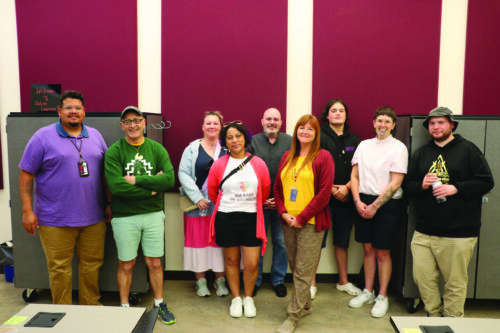
Following a trip by Cherokee High School students and faculty to New Zealand in April, a group of Māori visited Cherokee. Shown at the school on the afternoon of Tuesday, Oct. 10 are, left to right, Catcuce Tiger, Cherokee Language instructor at Cherokee Central Schools; Stan Tawa, manager of Māori Studies at the Ara Institute of Canterbury; Amy Henderson, Māori Indigenous Midwifery student; Louise Courtney, a Māori who is a recent graduate of Indigenous Studies; Dr. Allen Bryant, Appalachian State University Gadugi Partnership; Dr. Debora Foerst, CHS principal; Te Atetangi Paris, a Māori Language student; Te Kurawahiti Hitchens, a Māori Language student; and Isileili Paris, a Māori Language student. (SCOTT MCKIE B.P./One Feather photo)
Louise Courtney, a Māori, is a language student, and commented, “The similarity (between the two language revitalization efforts) would be in the aspiration to retain and grow, restore the language. It’s something that is a normal part of our everyday. I think that’s where those dreams and aspirations are for our future. Not everyone can see that as being something that they can achieve for themselves, but certainly if we can see it forward then it becomes something normal for future generations.”
“What we’re working on, I guess, is trying to normalize it. I think one of the things they noticed when they arrived in New Zealand is that we have a dedicated television channel (in Māori). But also, there’s a lot of words and a lot of phrases that are actually part of everyday life that you don’t really realize is an Indigenous language.”
While in the area, the Māori contingent visited several Cherokee sites including Kituwah, New Kituwah Academy, Snowbird Community and the Junaluska Memorial, as well as participating in activities such as attending the EBCI Inauguration, the Cherokee Indian Fair Parade, a Cherokee Braves football game, and much more.
The Cherokee contingent who traveled to New Zealand, and visited Māori cultural sites in and around the area of Christchurch, included: Dr. Debora Foerst, Cherokee High School principal; Catcuce Tiger, Cherokee Language instructor at Cherokee Central Schools; Dr. Allen Bryant, Appalachian State University Gadugi Partnership founder; EBCI tribal member Darius Lambert; and the following Cherokee High School students – Idalis Crowe, Katharine Armachain, Carys Holiday, Brandon Santiago, and Luke Climbingbear.
Of her trip, Crowe, an EBCI tribal member, commented, “I have been learning the Cherokee language practically all of my life. Going to a school where Cherokee language class is required year-after-year up until high school, where you are then only required a semester of it, you would think I should be fluent by now? Sadly, that is not the case.”
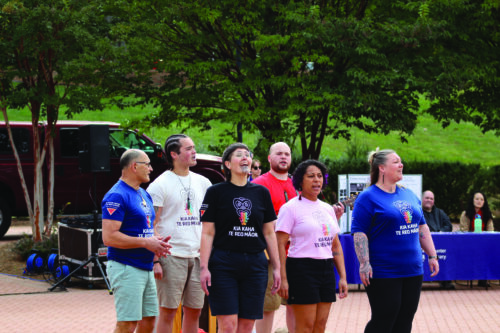
The Māori contingent performs a Haka during Western Carolina University’s Indigenous People’s Day Celebration on campus in Cullowhee, N.C. on Monday, Oct. 9. (BROOKLYN BROWN/One Feather photo)
She added, “But, while I was in New Zealand I became more motivated than ever before to reclaim my language. I was able to learn so much during the trip to New Zealand, but one thing in particular that stood out to me was the similarity of historical struggles of colonialism between the Cherokee and Māori. Both cultures, and their respective languages, have suffered immensely as a result of indoctrination.”
“One thing that sets our cultures apart today though is the wonderful amount of success the Māori have had with their cultural and language revitalization efforts. I hope to one day see the same kind of success with the Cherokee, but it won’t be without selflessness, dedication, and hard work.”
Dr. Foerst noted, “As an educator, I have always believed students learn more outside of the classroom than inside the classroom when it comes to student travel experiences. In the best of classrooms, we can still only offer a limited perspective, but traveling shows students history, culture, languages, etc. in a way the classroom never can.”
“This cultural collaboration and the experiences it has afforded our students provided all those advantages of student travel and so much more. While in New Zealand, I watched our students connect with the Māori people in such a unique way. It is a kinship that blossomed out of true understanding and acceptance. Both groups of indigenous people were colonized, and forced assimilation led to the near loss of their identities.”
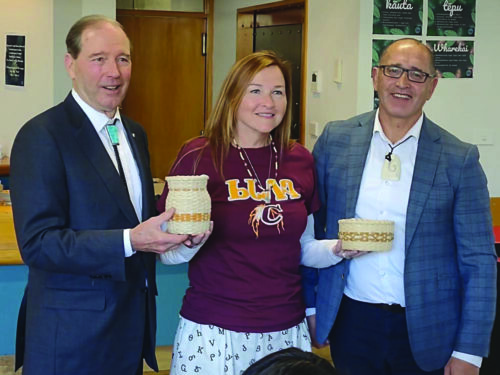
Dr. Debora Foerst, center, CHS principal, presents Cherokee White Oak baskets to Tom Udall, left, U.S. Amabassador In New Zealand, and Stan Tawa, manager of Māori Studies at the Ara Institute in Canterbury. (Photo courtesy of Cherokee Central Schools)
Dr. Foerst went to say, “This understanding and acceptance encouraged our students to be open to sharing, bold to try new things, and inspired to learn more of their own Cherokee language and about their own traditions. That inspiration comes from the efforts of the Māori to save their identity by saving their language, customs, and traditions.”
Stan Tawa, a Māori who serves as the manager of Māori Studies at the Ara Institute of Canterbury, commented, “Never undervalue who you are…they (the CHS students) are amazing. Amazing representatives of this community, of their people. We just love them.”
Tawa said, “It’s great. You see these things on TV. But when you actually get in this place, you get the value of community. You get the value…especially in small spaces like this where everybody is everybody, real close together. I love it. I really do love it.”
“I really think it’s just been so much to take in. I’ve been taking notes…the hospitality and the people have been amazing.”
Tiger, an EBCI tribal member and Cherokee Language instructor at Cherokee Central Schools, said seeing the language revitalization of the Māori during their trip to New Zealand was inspiring. “To see it happening, I just became overwhelmed with emotion…I said, ‘it’s just so inspiring to see where you guys are at’. And they’re not where they want to be either, I think, but it gives me hope. We can do it but it’s going to take a whole lot more work than what we’re doing now. We’re just going to have to gear up even more and work even harder to get that. But it gave me hope.”
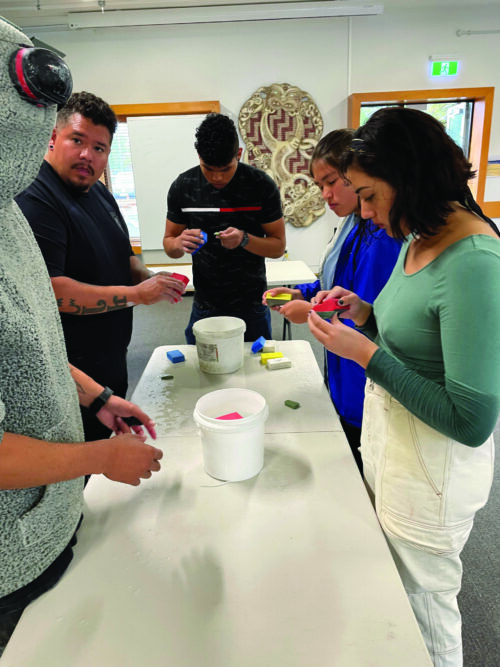
Catcuce Tiger, Luke Climbingbear, Carys Holiday, and Idalis Crowe shine Pounamu necklaces they made in New Zealand. (Photo courtesy of Cherokee Central Schools)
He said more work is needed. “Hopefully we get to a point to where it’s just what they (kids) know, and I think it’s happening with the younger ones, like with my kids, for example. But, it’s going to take a lot more continued effort. What we’ve done is good, but we’re not anywhere near where we need to be. But, it was a breath of fresh air for me that what we’re doing is going to work, but it’s just going to take a lot more time.”
“What I try to do on a daily basis is to instill pride into the kids because I feel that they feel connected, but I don’t think a lot of them feel that they have a lot of cultural or language knowledge to feel that they’re real owners, agents, of their future and their culture.”
Dr. Allen Bryant, faculty director of Indigenous Communities and associate professor in the Department of Learning, Teaching, and Curriculum at Appalachian State University, is the founder of Appalachian State’s Gadugi Partnership. He went to New Zealand and was present for the Māori visit to Cherokee. “The primary goal was the language revitalization piece. Then a close second was to sort of build this relationship between the EBCI and the Māori. One of the things that I’m convinced of is if Indigenous people can find each other and can connect with each other and partner with each other, we’re going to be pretty hard to stop. I think there’s power in those connections.”
In speaking about the magnitude of the trip to New Zealand, he noted, “It was an amazing experience. It was extraordinary to be able to be there. One of the things that I thought was most useful was…hope can be in short supply here when it comes to talking about the language. Sometimes, I think the conversation seems to be ‘well, it’s on its way out’ and what we learned from them, what we gained from them, was just this sense of hope. Because, as they had told us, 25 years ago they were in the exact same situation that the EBCI is in with regard to their language. And now it is flourishing and it is thriving. So, I think for our young people here, who very often have that sort of notion that this is a burden that maybe can’t be met, we learned from them that it can. It absolutely can. And that was so valuable for all of us. It’s hard to make change if you don’t have hope.”
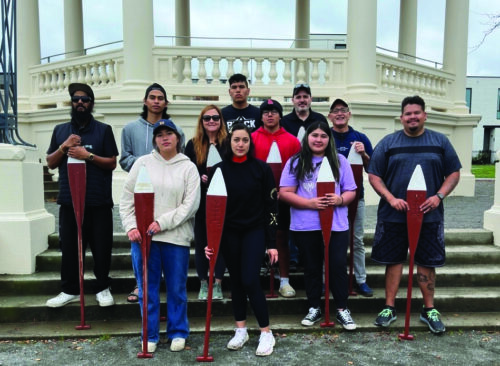
The group is shown, left to right, after paddling on a waka in New Zealand: front row, Carys Holiday, Idalis Crowe, Katherine Armachain, Catcuce Tiger; middle row, Dr. Debora Foerst, Brandon Santiago, Stan Tuwa; back row – Māori Waka guide, Darius Lambert, Luke Climbingbear, and Dr. Allen Bryant. (Photo courtesy of Cherokee Central Schools)
Dr. Bryant was very pleased with the outcome of the trip. “We got to spend two weeks really immersed in Māori culture. It was very powerful for all of us – really, really, powerful…When you live in a place, it’s so easy to take it for granted. So, to watch them (the youth) awaken to how special the community is – that was great.”
“We’ve built something that is so much more than academic. I value academics a great deal, but this is considerably deeper than that.”
Te Kurawhiti Hitchens is dedicated to studying her Māori language. “I’m a language student and I’ve been learning my own language over the last few years. So, seeing them, seeing the efforts to revitalize language and culture is really exciting for me. I think, as well, just seeing the way that the people are taking back their own story – to tell your own story and that sense of agency, especially through art…I’m a musician, a lot of my friends are artists, so seeing how that’s used as a vehicle for cultural and language revitalization really excites me as well.”
Coming to Cherokee was inspiring to her. “I think the community stuff is the biggest thing for me. Seeing the sense of community here and the way that people are working within families and within tight-knit communities to revitalize those things, I think that’s the biggest thing that I want to take back. We’re doing ok in terms of schools and language in schools, but I think in the community and for those who aren’t in a school or aren’t able to learn through institutions that’s where we really need to be working on.”
Hitchens is very deliberate in her language learning efforts. “I surround myself with a lot of Māori and I make the effort to intentionally seek out relationships where I use the language. For people who don’t do that, if their family doesn’t speak Te Reo, which is common, there’s not heaps of opportunities. You can greet people in Te Reo and use a few words that people will understand, but you really do have to be quite intentional to put yourself in communities where you’re actually using lots of language every day.”





